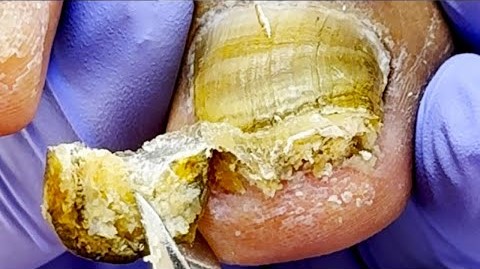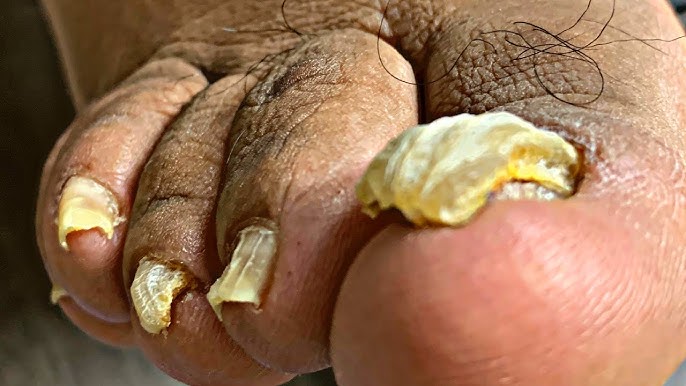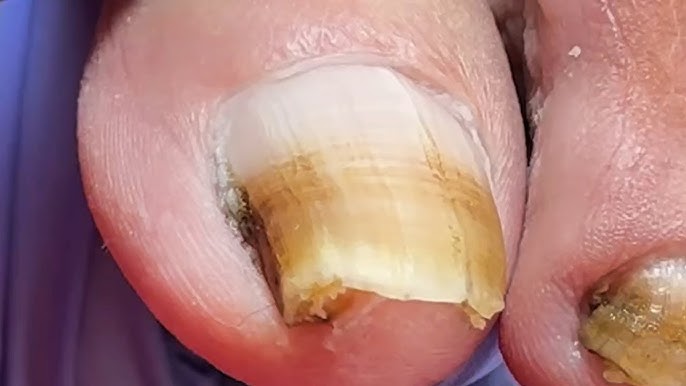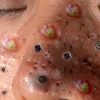Nail fungus, also known as onychomycosis, is caused by a fungal infection that affects the nails, usually the toenails. It can occur when fungi enter through small cracks or cuts in the nail or surrounding skin. Some common causes and risk factors include:

-
Fungal Exposure: Fungi thrive in warm, moist environments. Walking barefoot in public places like swimming pools, gyms, or showers increases exposure to these fungi.
-
Poor Nail Hygiene: Not keeping nails clean and trimmed can increase the likelihood of infection.
-
Weakened Immune System: People with weakened immune systems, such as those with diabetes or those on medications that suppress immunity, are more prone to fungal infections.

-
Injury to the Nail: Trauma or damage to the nail can provide an entry point for the fungus.
-
Age: Older adults are more likely to develop nail fungus due to slower nail growth and reduced circulation.
-
Tight, Non-Breathable Footwear: Wearing tight shoes or socks that don’t allow proper airflow can create a warm, moist environment ideal for fungal growth.
-
Underlying Health Conditions: Conditions like diabetes, circulatory problems, and immune system disorders make individuals more susceptible to infections, including nail fungus.

Nail fungus can be challenging to treat, but there are several methods available depending on the severity of the infection. Here are some common treatments:
1. Topical Antifungal Medications
- Over-the-counter creams or ointments: These can be effective for mild cases of nail fungus. Common antifungal ingredients include clotrimazole, terbinafine, or miconazole.
- Prescription antifungal lacquers: A medicated nail polish like ciclopirox can be applied directly to the infected nail. It’s generally applied daily and can take several months to show results.
2. Oral Antifungal Medications
- Terbinafine (Lamisil): A commonly prescribed antifungal tablet that helps to clear the infection from the inside out. Typically taken for several weeks to months.
- Itraconazole (Sporanox): Another oral option that may be prescribed if topical treatments don’t work.
- Oral medications tend to be more effective but can come with potential side effects, such as liver damage, so they should be used under medical supervision.
3. Laser Treatment
- Laser therapy: This involves using lasers to target and kill the fungi beneath the nail. This is a newer treatment option that may be recommended when other treatments haven’t worked.
4. Nail Debridement
- Trimming and thinning the nail: A healthcare provider might trim or file down the infected nail to reduce pressure and allow topical treatments to penetrate more effectively.
5. Home Remedies (Less Effective)
- Tea tree oil: Some people use tea tree oil, known for its antifungal properties, by applying it directly to the affected nail. While not scientifically proven to be highly effective, it may help in mild cases.
- Vicks VapoRub: Some individuals find relief by applying Vicks VapoRub, which contains menthol, eucalyptus, and camphor, though evidence for its effectiveness is limited.

6. Surgical Removal
- Nail removal: In severe cases, where the fungus does not respond to other treatments, a doctor may recommend removing the infected nail. This can help to eliminate the source of the infection.
7. Good Nail and Foot Care
- Keep nails trimmed and dry: Moisture encourages fungal growth, so keeping nails dry and clean can help prevent reinfection.
- Disinfect shoes and socks: Since the fungus can live in shoes and socks, it’s important to regularly clean or disinfect them to avoid recontamination.
It’s important to note that nail fungus can be stubborn, and treatment may take several months before you see improvement. Consulting with a healthcare provider is recommended to determine the best course of treatment for your specific situation.


